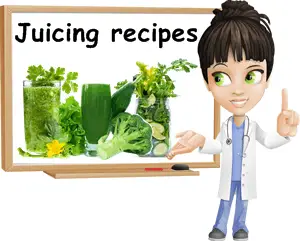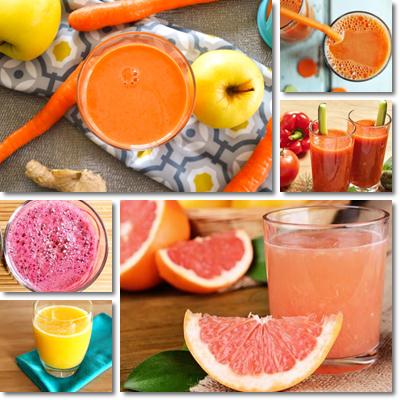Juicing is a form of healthy eating that could suit most lifestyles and tastes. But despite the simplicity of the concept, anyone attempting it knows that there is more to it than simply making juice out of fruits and vegetables.
In fact, pairing fruits and vegetables together to get a palatable drink may be one of the most puzzling issues to deal with. And while we may be willing to invest in a pricey juicer and spend hours making our favorite drinks, most of us draw the line at unappealing taste.
There are plenty of reasons why juicing is the newest health craze. First of all, juices are easily digested, the nutrients in them readily absorbed and our intake of essential nutrients surprisingly high.
Juicing is actually a favorite form of detoxification for health enthusiasts everywhere. The only problem is taste. For them to actually provide serious benefits without many side effects, juices would have to contain about 80% vegetables (and we all know how good leafy greens taste) and be from organic agriculture.

Juicing explained: important aspects about juicing. Taste is a relevant aspect when it comes to juicing. Nobody wants to have to hold their nose to be able to drink their juice.
According to experts, for juices to actually contribute to our health in one way or another, they would have to contain about 80% vegetables, particularly green leafy vegetables but also carrots, beets, cucumbers etc.
Vegetables, especially raw ones, may not be the most palatable options for many people so in order to make juices healthy and tasty we have to know how to achieve the most savory combinations.
Fruit juices alone are not the best option if we consume more than 3 glasses a day, unless they are the only sugar source we enjoy. Aside from upping our sugar intake, the acidity of some fruits may cause our teeth to become tender and hurt (citrus fruit, mango, etc.) or even upset our stomach (pineapple, for example).
Also, while fruit juices do supply higher amounts of essential nutrients than the whole fruits they also contain too much sugar.
As such, experts recommend either juicing one or two fruits with double the amount of vegetables or eating the whole fruit instead of juicing it (is it better to eat fruits or drink fruit juice?).
Tips for juicing
While we do have to acquire the taste for juiced vegetables since they’re not sweet like fruits, but rather bitter, there are some tricks we can rely on to help us learn to love them:
1) Chilling fruits and vegetables prior to juicing them.
2) Adding ice cubes.
3) Alternating vegetables for a more varied taste experience.
4) Combining ingredients so they complement each other’s flavor.
5) Adding lemon juice, ginger, fennel, cilantro and other herbs and spices to improve taste.
6) Adding sparkling water, especially to concentrated green vegetables juices.

In order to make juices taste better, chilling our vegetables for several hours prior to juicing them or adding some ice cubes can help improve the experience mainly because cold numbs the tongue a little so we might not perceive the bitter taste of some vegetables as intense.
Adding carrots which are sweeter or cucumber which is both refreshing and a little bland to vegetable-only juices can make them more palatable.
Using herbs and spices such as ginger, basil, cilantro and lemon juice can give vegetable juices a pleasant twist, while sparkling water can make them more refreshing and easier to drink.
But taste being the main issue, it is only reasonable that we make the juices taste good. And this is done by learning which combinations of fruits and vegetables we like best.
Most common ingredients for juicing include: apples, beets, cabbage, celery stalks, chard, carrots, cucumbers, kale, lettuce, pear, pineapple, oranges, spinach, tomatoes, ginger, lemon, mint as well as mango, parsley etc.
10 Juicing recipes: combinations
Depending on personal preference, juices recipes may be:
1) One-ingredient juices.
2) Two-ingredient juices.
3) Multiple-ingredient juices.
Beginners might want to discover how each vegetable and fruit juice tastes like by itself. Carrot juice, beets juice, spinach juice, tomato juice or cucumber juice are good choices for juicing newbies. Go through the whole range of one-ingredient juices, particularly those made from green leafy vegetables, until you acquire the taste and learn to appreciate it for its uniqueness and richness.
Combinations may then follow.
Here are 10 delicious and savory fruits and vegetable combinations to make you love juicing:
1) Red cabbage and red pear juice. Juice together 4-5 leaves of a medium-sized red cabbage and two medium-sized red pears (about 300-350 g). Drink fresh.
2) Carrot, pear and celery juice. Juice 3 larger celery stalks (about 200 g), 2 medium-sized apples (about 150 g) and one medium-sized pear (about 150 g).
3) Beets, carrots and oranges juice. Juice 200 g of red beetroot, 250 g of orange pulp and 2 medium-sized carrots (about 140 g).
4) Apple, carrots, collard greens and kale juice. Juice one apple (200 g), 3 medium-sized carrots (about 200 g), 1 cup of collard greens (about 50 g) and 4-5 kale leaves.
5) Apple, celery, cucumber and dandelion greens juice. Juice and mix 2 medium-sized apples (about 350 g), 2 celery stalks (about 100 g), 150 g of cucumber and 1 cup of dandelion greens. Add lemon for extra flavor.
6) Dandelion greens, beets, orange, carrot and kale. Juice 1 cup of dandelion greens, 2 kale leaves, 1 small red beet (about 100 g), 3-4 medium-sized carrots (about 250 g) and 150 g of orange pulp.
7) Spinach, celery, kale and apple. Juice about 150 g of spinach leaves, 2 celery stalks (about 200 g), 2 kale leaves and 3 apples (about 650 g).
8) Apple, cucumber, kale and spinach. Juice 2 medium-sized apples (about 350 g), 300 g of cucumber, 4 kale leaves (about 150 g) and 80 g of spinach leaves.
9) Broccoli, cucumber, romaine lettuce, spinach and apples. Juice about 200 g of broccoli, 200 g of cucumber, 200 g of romaine lettuce and 2 medium-sized apples (about 350 g).
10) Mango, pineapple, orange and kale. Juice 1 large ripe mango (about 350 g, pulp only), 175 g of chopped pineapple, 100 g of orange pulp and 4-5 kale leaves (about 150 g).
My favorite 4 combinations include:
1) Spinach, parsley and apple.
2) Kale, carrots and a bit of ramsons (aka wild garlic, Allium ursinum).
3) Celery, cucumber and carrots.
4) Red beets, carrots and oranges.
While I like my juices simple (no lemon, lime or other spices), I often add one glass of sparkling water to each glass of concentrated juice. I find it helps me stay hydrated and makes the juice taste better.
The more greens you add to the the drink, the healthier it is. However, it’s quite okay to mix 2-3 vegetables with 1-2 different types of fruit.
Adding lemon juice, ginger or any other herb you like can give your juices a pleasant twist and make them more palatable.
Food for thought
While juicing is a great way to complement an already clean, varied and balanced diet, it is actually not so good as a detoxification diet of its own, especially one that is practiced continuously.
Raw vegetables contain numerous anti-nutrients that decrease the amount of nutrients our intestines absorb, are hypo-caloric and thus do not supply sufficient calories for an active lifestyle, unless we consume large amounts, which is also time consuming and quite pricey. Not to mention the gastrointestinal effects (loose stools, diarrhea, possibly also bloating, gas, burping, stomach pain and discomfort).
Finding a balance is always hard, especially when it comes to healthy eating and healthy living. But making informed decisions about what we eat and how we do it is the key to better health. Juicing works best when it complements and already varied and balanced diet. Drinking juices alone or resorting to a 2-day or 5-day juice fasting to undo years of bad eating is not the solution. We have to be consistent in our desire to be healthy and this means eating right and, of course, enjoying a delicious glass of fruit and vegetable juice from time to time.
